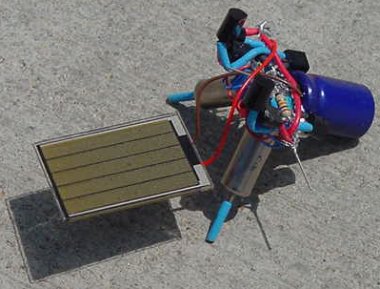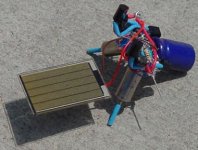Manual says 125, textbooks say 150, comments in some application guides for the outputs suggest it does better at 110. I find it curious it can barely do 110. Not too worried about it at this point. I'll think about that after I do some measurements and think about the first mods.
The Vbe multiplier with the 2N2222 has a limited range based upon what must have been typical turnon characteristics of the output devices at the time of the original build. Evidently the latest ones require a bit more. You can either make R8 a little smaller or R9 a bit larger to get more output stage bias.
[snip] I assume that the 100μF/1μF/0.1μF are placed at EACH power device, and not just once per rail per board. Otherwisae the trace inductance would either degrade your transient response or increase the rail voltage disturbance amplitude, or some of both, not to mention the increased potential for high-frequency instability. (If any newer newbies than I ever read this thread: A good main power supply is a must. But unless the power rails are extremely short the PSU isn't sufficient for a great transient response and decoupling caps are needed, basically to act as small local power supplies, right at each point of load.)
Have you determined the decoupling capacitance value that would be needed for each output transistor for the worst-case transient current-slewing event, given a maximum allowed resulting power rail voltage disturbance, and the worst-case parasitic inductance that could be tolerated in that case, between the decoupling capacitance and the device?
Even just for an LM3886 to swing 5 Amps per microsecond for only two consecutive microseconds, and allowing for a spec of up to 0.1 V rail disturbance, with only one inch of round-trip trace length (say 15 nH, but would be more with bigger traces) between the main decoupling cap and each power pin and gnd, it would require about 200 uF minimum, if I recall correctly, implemented with three paralleled caps of 68μF each in order to lower the inductance enough to have the necessary speed. I realize that might not be a very realistic example for an LM3886. But hopefully it shows that it might be necessary to really make sure that what decoupling you are using, and exactly where, is actually sufficient.
And how do you decide that 1 uF and 0.1 uF are what is best, each time? Most people don't. And they're probably not.
Just food for thought.
One caveat about paralleling caps. Frequently the inductance of one of them will ring with the capacitance of a smaller one, making the net impedance at the point quite a bit more complex than at first glance. One may do still better with some damping resistances placed strategically, in series with some of them.
Brad
My experience suggests that this is not always the case - especially to the ears of the system's owner.
For example, in many occasions getting more detail and removing the coloration of source/amplifier components (to the extent possible) causes deficiencies of the loudspeakers (and even loudspeaker/room combo) to become more evident.
To make things worse people are not always ready to accept that the aggressive highs they hear come from the jewel of their system, those brand new and expensive loudspeakers, and not from their new DAC or power amp.
Or that really their listening room and speaker positioning is not suited to those 4x 10'' drivers they paid $$$$ to get and show off - at least not when those drivers get enough power and actually move
Thanks, you just confirmed my point: expecting improvements people often screw down things. It does not mean they improved sound quality. The point is about improving sound quality, and correlation of improvements with measurements. If combination of amp and speaker caused quite good overall frequency response the new amp that adds say unnecessary damping makes results worse. Is it real improvement of sound quality? No. Did the system need such improvement? No. The right way to improve is to plan what you are going to improve in sound quality, to predict what else will be changed, and if improvement worth it go for it.
One caveat about paralleling caps. Frequently the inductance of one of them will ring with the capacitance of a smaller one, making the net impedance at the point quite a bit more complex than at first glance. One may do still better with some damping resistances placed strategically, in series with some of them.
Brad
Does that explain the R24 and R23 in the DH-120?
After 1800 posts, I think measurement wins.
Without measurements and nerds we would not have any sound quality, we would not have sound.
Without measurements we would not have electronic sound.
Heck even a stringed instrument has measurements, from the scale of the neck, the gauge of the string, the frequencies to which the strings are tuned, the volume and thickness/density of the body etc.
So why do some (measurements) sound better then others? -Golden Ratio.
The best tweaks are ones that align themselves to this simple Fibonacci formula.
If you reverse engineer the Fibonacci ratio, you will have the measurements needed to construct your own sound machine of the heavens.
Case closed, I think the troll won this one.
Without measurements and nerds we would not have any sound quality, we would not have sound.
Without measurements we would not have electronic sound.
Heck even a stringed instrument has measurements, from the scale of the neck, the gauge of the string, the frequencies to which the strings are tuned, the volume and thickness/density of the body etc.
So why do some (measurements) sound better then others? -Golden Ratio.
The best tweaks are ones that align themselves to this simple Fibonacci formula.
If you reverse engineer the Fibonacci ratio, you will have the measurements needed to construct your own sound machine of the heavens.
Case closed, I think the troll won this one.
Thanks, you just confirmed my point: expecting improvements people often screw down things. It does not mean they improved sound quality. The point is about improving sound quality, and correlation of improvements with measurements. If combination of amp and speaker caused quite good overall frequency response the new amp that adds say unnecessary damping makes results worse. Is it real improvement of sound quality? No. Did the system need such improvement? No. The right way to improve is to plan what you are going to improve in sound quality, to predict what else will be changed, and if improvement worth it go for it.
I know what you mean but I honestly don't believe that hiding issues under the carpet is the right way to improve a system.
If your loudspeaker's tweeter bothers you or if your room is too "lively", there is no point in masking those problems. Change loudspeakers or tweak it if you're into DIY. Treat your listening room and experiment with speaker placement. Address the real issue.
Buying a source with muffled highs just to make your speakers' tweeter bearable means you're trying to offset one error with another. The end result is that you end up with one more error. This is not only wrong (from a technical point of view) but also highly unpredictable and thus ineffective (i.e. good luck trying to find the combination of errors that'll be acceptable and don't forget to wave good bye to high fidelity).
Not to mention it's what incompetent gear designers hope for in terms of consumer attitude in order to sell their stuff. "There is no bad component. It's all about the synergy". Yeah, right!
Last edited:
Glo, bug,
Although the golden ratio is pleasing in proportions of furniture,it has nothing to do with designing amplifier circuits. It may be useful in designing the expensive cabinet work necessary to sell in the very high end.
So Shamam, who the heck was Andrew Jones? I assume a mathematician who was jealous that engineers actually get paid. I work with a bunch of math types. Bright people. Frequently need help finding the on/off switch on their computers.
How dare you expose the tube-preamps-to-fix-the-evil-CD marketing system! A troll in e-may is quite entertaining. I would rather see folks continue to improve tubes as voltage amplification devices. They actually have some advantages, like when the solar flairs cook all our ss, tubes will work fine. Of course, we'll have no power grid to heat them up.
Although the golden ratio is pleasing in proportions of furniture,it has nothing to do with designing amplifier circuits. It may be useful in designing the expensive cabinet work necessary to sell in the very high end.
So Shamam, who the heck was Andrew Jones? I assume a mathematician who was jealous that engineers actually get paid. I work with a bunch of math types. Bright people. Frequently need help finding the on/off switch on their computers.
How dare you expose the tube-preamps-to-fix-the-evil-CD marketing system! A troll in e-may is quite entertaining. I would rather see folks continue to improve tubes as voltage amplification devices. They actually have some advantages, like when the solar flairs cook all our ss, tubes will work fine. Of course, we'll have no power grid to heat them up.
I know what you mean but I honestly don't believe that hiding issues under the carpet is the right way to improve a system.
I honestly don't see how making sound quality worse you are hiding something under the carpet making sound quality better. It is either worse, or better. Like, if you remove a pile of garbage from carpet, but see that carpet is dirty, you did not make the room dirtier: the carpet was dirty always. There were 2 sources of dissatisfaction, one of which dominated. Now another dominates, but overall it is cleaner. At least, you don't have a pile of garbage anymore, so can continue improvement, cleaning your carpet.
Offsetting error with another, like in your example, is actually very different thing., It is called equalizing. Equalizing seems bad only and only when you do some measurements against wrong expectations. Removing it you don't improve sound system's quality.
Glo, bug,
Although the golden ratio is pleasing in proportions of furniture,it has nothing to do with designing amplifier circuits. It may be useful in designing the expensive cabinet work necessary to sell in the very high end.
Actually, golden ratio is very related to the topic. The further are proportions and other properties of furniture to what we expect from nature, the more artificially it looks. The same with audio. You wife don't care if high THD amp mimics mechanical media distortions, but if it has a little bit of own type of them that are far from what we can expect in physical reality she does not like the amp.
Compare 2 different pictures: first one is natural, follows Fibonacci, another one shows very functional robot that does the job he is programmed to.


Last edited:
Does that explain the R24 and R23 in the DH-120?
Possibly. Methinks there may have been some marginal stability issue.
This Golden Ratio was used to compose this song using nothing more then the Fibonacci ratio.
Who says musicians are talented, I say they are good with math.
Debussy: Reflections in the Water - Images, Book 1 - YouTube
Here is another fine example: Sonnneries de la Croix / Eric Satie
-1:2:3:5:8:5:3:2:1 Satie, Sonneries de la Rose + Croix no 1, Lent et détaché, Air Of The Order - YouTube
Who says musicians are talented, I say they are good with math.
Debussy: Reflections in the Water - Images, Book 1 - YouTube
Here is another fine example: Sonnneries de la Croix / Eric Satie
-1:2:3:5:8:5:3:2:1 Satie, Sonneries de la Rose + Croix no 1, Lent et détaché, Air Of The Order - YouTube
Here is another fine example: Sonnneries de la Croix / Eric Satie
-1:2:3:5:8:5:3:2:1 Satie, Sonneries de la Rose + Croix no 1, Lent et détaché, Air Of The Order - YouTube
Yes, and Harmony of Universe is in the roots of ages old Rosicrucian teachings.
[snip]
So Shamam, who the heck was Andrew Jones? I assume a mathematician who was jealous that engineers actually get paid. I work with a bunch of math types. Bright people. Frequently need help finding the on/off switch on their computers.
[snip]
I'm not certain, as there are many Andrew Joneses, but he may be the speaker designer who used to work for Infinity and has more recently been with Pioneer.
I would add to the "hierarchy" at the head of the AJ list, the Platonist philosopher, who introduces the notion that numbers are real.
I have a great anecdote about the response of the mathematician, the physicist, and the engineer to the proposition that all odd numbers are prime, but this thread is hard to get through already

Brad
Possibly. Methinks there may have been some marginal stability issue.
Yea, there are a few hints at that! I notice the compensation got simpler as he progressed through the the servo 100 series. I am still struggling to understand all of it. I hope Simetrix helps.
With Exicon outputs, still seems stable. Never noticed, Fairchild is nice enough to provide Spice models.
One caveat about paralleling caps. Frequently the inductance of one of them will ring with the capacitance of a smaller one, making the net impedance at the point quite a bit more complex than at first glance. One may do still better with some damping resistances placed strategically, in series with some of them.
Brad
Now, here's a thought to tickle my curiosity. Good thinking, Brad, thank you!
And all this while, nobody, not even those known to use them, has even mentioned capacitance multipliers ...
Odd little circuits. They are most deceptively simple and easy, but getting one to work as advertised is no easy job.
This Golden Ratio was used to compose this song using nothing more then the Fibonacci ratio.
Who says musicians are talented, I say they are good with math.
Debussy: Reflections in the Water - Images, Book 1 - YouTube
Here is another fine example: Sonnneries de la Croix / Eric Satie
-1:2:3:5:8:5:3:2:1 Satie, Sonneries de la Rose + Croix no 1, Lent et détaché, Air Of The Order - YouTube
Golden ration, is 3-5-7. That does not show up in Fibonacci.
Both sequences show up in nature. We seem to be attuned to them. Pleasing to look at, pleasing to hear. Fractals show up everywhere too. But still, I am waiting for someone to suggest how this has anything to do with amplifier circuit design. Don't bother if you suggest it has to do with "optimum cable stranding" with all due respect to Noel, he has made a tidy living at it.
But still, I am waiting for someone to suggest how this has anything to do with amplifier circuit design.
Please see my previous posting with pictures.
- Status
- Not open for further replies.
- Home
- Member Areas
- The Lounge
- Sound Quality Vs. Measurements

